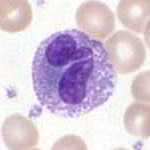Polymorphonuclear leukocytes
| Granulocyte | |
|---|---|

An eosinophilic granulocyte.
|
|
| Details | |
| System | Immune system |
| Identifiers | |
| MeSH | D006098 |
|
Anatomical terms of microanatomy []
|
|
Granulocytes are a category of white blood cells characterized by the presence of granules in their cytoplasm. They are also called polymorphonuclear leukocytes (PMN, PML, or PMNL) because of the varying shapes of the nucleus, which is usually lobed into three segments. This distinguishes them from the mononuclear agranulocytes. In common parlance, the term polymorphonuclear leukocyte often refers specifically to "neutrophil granulocytes", the most abundant of the granulocytes; the other types (eosinophils, basophils, and mast cells) have lower numbers. Granulocytes are produced via granulopoiesis in the bone marrow.
There are four types of granulocytes:
Their names are derived from their staining characteristics; for example, the most abundant granulocyte is the neutrophil granulocyte, which has neutrally staining cytoplasmic granules.
Neutrophils are normally found in the bloodstream and are the most abundant type of phagocyte, constituting 60% to 65% of the total circulating white blood cells, and consisting of two subpopulations: neutrophil-killers and neutrophil-cagers. One litre of human blood contains about five billion (5x109) neutrophils, which are about 12–15 micrometers in diameter. Once neutrophils have received the appropriate signals, it takes them about thirty minutes to leave the blood and reach the site of an infection. Neutrophils do not return to the blood; they turn into pus cells and die. Mature neutrophils are smaller than monocytes, and have a segmented nucleus with several sections(two to five segments); each section is connected by chromatin filaments. Neutrophils do not normally exit the bone marrow until maturity, but during an infection neutrophil precursors called myelocytes and promyelocytes are released.
...
Wikipedia
